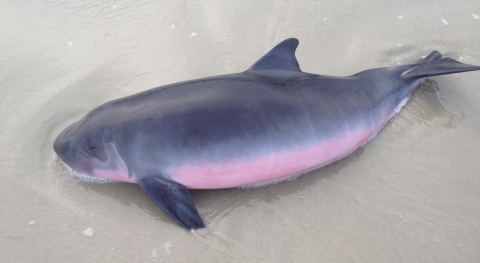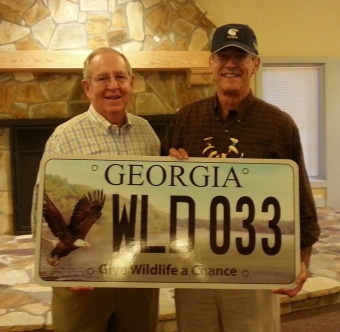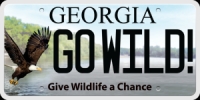Noteworthy
A Kogia cow and calf stranded this week on Cumberland Island. Preliminary findings indicate the mother and her young (calf pictured) were dwarf sperm whales. The few Kogia whales that strand each year on Georgia beaches are usually pygmy sperm whales, a closely related species. The last confirmed dwarf sperm whale stranding was in 2005. In the southeastern U.S., the species are considered common but little is known about them.
 Report stranded marine mammals alive or dead by calling DNR’s stranding hotline, 800-2-SAVE-ME (272-8363), or NOAA’s, 877-433-8299. Biologists advise against trying to return live-stranded animals to the ocean: Powerful flukes can cause injuries and the animals can have communicable diseases. Marine mammals that strand are most often sick or hurt; returning them to sea delays examination and treatment and often results in the animal restranding in worse condition.
Here’s your chance to help native birds and wildlife habitat near Atlanta. About 30 volunteers are needed to spread native grass seeds Saturday morning, June 28, as part of a grassland restoration project at Panola Mountain State Park. Details (and RSVP): DNR senior wildlife biologist Nathan Klaus and Georgia Important Bird Areas Coordinator Charlie Muise.
Loggerhead sea turtles topped 560 nests in the state this week. Cumberland Island is easily leading all barrier islands, with more than 150 nests. Meanwhile, 14 sea turtle strandings -- at least three of them from boat collisions -- were reported during a recent week. Updates.
 The peregrine falcon that fledged this spring from a balcony at SunTrust Plaza in Atlanta appears A-OK. Laura Miller of the law firm McKenna Long & Aldridge, which helps host DNR’s peregrine nest cam, snapped this shot of the bird, with prey, on Wednesday.
Mississippi is the latest state to confirm the presence of the fungus known to cause white-nose syndrome, the disease that has killed millions of bats in the eastern U.S. and Canada. White-nose was first documented in Georgia in 2013 ("Bat disease found in Georgia," March 22, 2013).
A decision on listing northern long-eared bats as endangered under the Endangered Species Act has been extended six months, according to the U.S. Fish and Wildlife Service. The 60-day comment period has also been re-opened on northern long-eared bats, one of 16 bat species found in Georgia.
Cannonballing an endangered manatee comes with a price. A federal judge in Florida recently sentenced two 22-year-old men who lured an adult manatee and calf to a dock with a water hose, then one of the men jumped on the animals. A Facebook video of the harassment led to an investigation, and penalties including fines of $2,000 to $3,000 and 175 hours of community service for each defendant.
Names in the news: Robert Ramsay will succeed Pierre Howard as Georgia Conservancy president when Howard steps down July 1. Ramsay is the group’s vice president of development and was once better known as a top professional fly-fishing guide. The Board of Natural Resources and DNR Commissioner Mark Williams honored former Nongame Conservation Section Chief Mike Harris at the board's meeting this week. Harris, now at-risk species coordinator for the Fish and Wildlife Service’s Southeast Region, was also toasted -- and roasted – recently at Charlie Elliott Wildlife Center. Gifts at the dinner included a nongame license plate presented to Harris (right) by TERN board member Brooks Schoen and a "spirit of Ossabaw" hog tooth necklace, described by DNR Sea Turtle Program Coordinator Mark Dodd as "the highest honor Nongame's coastal office can bestow."
 Back to top.
Headlines
"U.S. declares wood storks no longer endangered," ABC News, and others via AP
"Ga. wildlife officials ask for help monitoring bats," WXGA-TV (Macon), and others via AP
"Birders' Eye View: Discovering an oystercatcher and manatee connection," Savannah Morning News
"Streaming eagles," The New York Times
"Sea turtle nesting on track to continue resurgence along Georgia coast," Saporta Report
"Bacon preservative tested as feral hog poison," WTVM-TV (Columbus)
"In a long-term experimental demography study, excluding ungulates reversed invader's explosive population growth rate and restored natives," Proceedings of the National Academy of Sciences
"Lula Lake Land Trust announces grand opening ceremony for Cloudland Connector Trail," WTVC-TV (Chattanooga, Tenn.)
"Researchers tap into social networks of endangered Indiana bat to aid in habitat management," Virginia Tech
"Colonial-era dams trigger parallel evolution of Connecticut fish," Yale
"In emergencies, fire ants get lots of grips to form rafts," ScienceNews
"See your lawn through a bird’s eyes with YardMap," ScienceNews
Video
"Alligator snapping turtle identification," Georgia DNR
"Goats spell trouble for invasive weeds," U.S. Fish and Wildlife Service
Back to top.
Credits
** Masthead: Blackwater wood stork colony in southwest Georgia. Tim Keyes/Ga. DNR
** Aerial shot showing part of Gilman's rookery in St. Mary's. Tim Keyes/Ga. DNR
** Volunteer Debbie Dineen helps band a 5- to 6-week-old wood stork. Tim Keyes/Ga. DNR
** Dr. Jenny Cruse-Sanders, center, of Atlanta Botanical Garden surveys dwarf sumac at Lower Broad River WMA with Greening Youth Foundation interns Jamia Robinson, left, and Takiyah Thomas of Spelman College. Mincy Moffett/Ga. DNR
** Dwarf sumac. Hugh Nourse
** Brazilian pepper found off Jekyll causeway. Eamonn Leonard/Ga. DNR
** Kogia calf that stranded on Cumberland. Nicole Brandt/Ga. DNR
** Young peregrine on SunTrust Plaza balcony. Laura Miller/McKenna Long & Aldridge
** Mike Harris, right, with TERN board member Brooks Schoen. Jenifer Hancock/Ga. DNR
 Give wildlife a chance!
The Nongame Conservation Section of Georgia DNR receives no state funds to conserve nongame wildlife, native plants and natural habitats. Instead, we depend on contributions, grants and fundraisers, such as the eagle and hummingbird license plates.
How can you help?
|